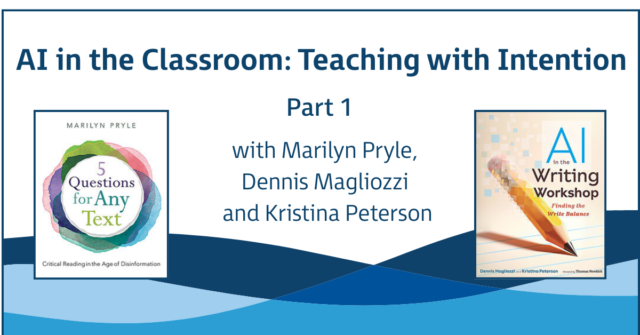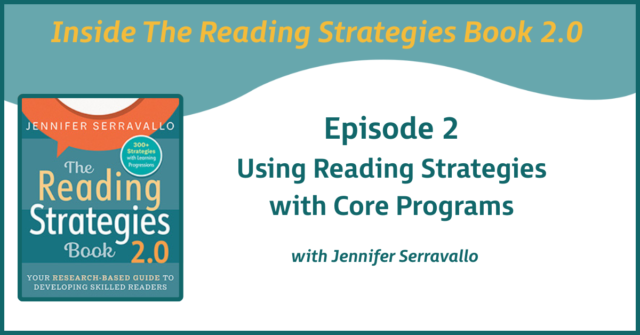
How can we help students move from general understanding to pinpointing an author's exact position?
In 5 Questions for Any Text, educator and author Marilyn Pryle offers a practical framework to help students navigate today's media landscape with sharper, critical thinking and deeper awareness.
In the second episode of this four-part series, we explore how to teach students to identify claims in nonfiction text. Those clear persuasive statements that go beyond just central ideas. This episode offers practical strategies to help your students read more critically and recognize persuasive techniques in everyday media. Listen in to this excerpt from Marilyn's audiobook, followed by a reflection and a few prompting questions from Marilyn.
Transcript
Marilyn Pryle (audiobook excerpt):
Readers might think about this category by asking themselves, what is the main idea, opinion, or thesis of this piece? Where in the piece is it spelled out or obvious? Or what is the author trying to prove or persuade the reader about? By middle school and high school, students have usually been trained to find the claim or thesis in a nonfiction text. It is a common question on standardized tests, even at the elementary school level. A claim is usually the text's central idea as well. But the difference between this category and the previous one is that a claim is stated outright and is argumentative, whereas a central idea may have to be inferred and could be informative or instructional. All claims are central ideas, but not all central ideas are claims. For this category, we want students to identify the exact sentence or sentences that spell out the position of the piece.
This could occur in the beginning of the text, at the end, or both. For examples, you could show students an op-ed from your local newspaper or your school newspaper. A commercial that clearly states its position or a product's alleged value. A product or book review. A website created to sell or persuade. Or a video with the same purpose. Claims are everywhere. Choose a few short texts that would be appropriate or interesting for your students and let them view and discuss. What might be surprising for them is realizing how many texts have claims embedded somewhere within them. When I ask my own students to identify the claim in a book review, they're initially stumped. In their minds, reviews are reviews and claims are for literary analysis or argumentative pieces. It's moments like these that demonstrate how students compartmentalize their learning from English class. When we review what a claim is, they understand that a book review with a position, rating and recommendation about the book does indeed have a claim.
This discussion also helps students see how genres are often mixed. A review can be informative, entertaining, and persuasive all at once. A commercial can be the same. An informative piece may also have a position in it. A comedy piece usually will as well. Our job as English teachers is not to teach these in isolation, but to help students peel back the layers of the information that courses around them. Let's listen to a few student reading responses for the cite the claim category. Here's 10th grader Carly's response to Malala Yousafzai's Nobel Peace Prize acceptance speech.
Malala's main focus of her speech is calling for others to take action on the injustice in the world. I think her main claim is, "Let this end with us." She begins the speech by telling her story and then talking about all the aspects of our world that need to change. I think by adding her personal experience, it brings more emotion and extends her call further. She talks about how the world has accomplished things before, the moon landing, which makes listeners realize that the world is capable of change. By saying, "Let this end with us," it almost brings guilt to the listener to take action and to do what you can do while you are on this Earth. It also brings togetherness by saying, "Us," implying that we can all do this together.
I asked Carly how this claim related to Malala's purpose for the speech and if she thought all Nobel winners might have a similar purpose or if purposes could vary for the Nobel moment. I also asked Carly if she could categorize the writing moves she mentions in her RR. Seeing the devices in the writing, such as personal narrative, emotional appeal, logic, and an appeal to unity, provides for metacognitive practice.
Here's a response from Hemanth, a seventh grader, to the article How Nicotine Affects the Teen Brain. In this article, the author conveys the message that nicotine is harmful and addictive for teens. For example, throughout the article, she further explains nicotine is addictive and harmful to teens and contains many health factors that are at risk. "Nicotine is a highly addictive drug with many health risks for teens." The article states facts and research topics over the effects nicotine has on teens. Including how it impacts your dopamine, a natural chemical your brain releases when you do something enjoyable. Behavioral issues, craving for nicotine, depression and et cetera. And how your brain development gets affected.
She's trying to prove to us that nicotine can really affect us on a long-term basis and that once we start, it's a rocky road to end. Hemanth pinpoints the claim in the article. Often students can explain the idea, but have a harder time pointing to the one sentence that encapsulates it. When conferring with him, I'd ask him to talk me through how he found it. Did he spot it right away or did he have to look for it? I wonder what Hemanth considered as the primary purpose of the author. When conferring with him, I'd ask, "Does the author directly try to persuade or are the facts alone persuasive enough? What are the direct persuasive appeals?"
Conferring with students. When we're conferring with students, we always begin by responding to them personally. Both Carly and Hemanth clearly understood the claims of their texts. I would commend both of them for this as it can be easy to understand the gist of a piece, but more difficult to point to one sentence. Each of them could be nudged to think more deeply about their text, but I would do this in a scaffolded way so that they could consider the options of what I would suggest to them without worrying about being wrong.
Once we've responded to the student, we can work on developing critical consciousness. Helping Carly name persuasive devices such as personal narrative, emotional appeal, logic, and an appeal to unity, would help her better understand how Malala's speech and persuasion in general works. There are many ways to persuade and I would want her to be aware of that as she consumed texts outside of school. In Hemanth's article, the facts themselves are used persuasively. I would still be interested to see if he could identify any direct appeals from the author. In this way, similar to Carly, he could recognize the different angles that persuasion can take. Finally, here's one last question for taking the conversation further. How do authors create persuasion in a text?
Marilyn (commentary):
This category is a traditional category in English classrooms. We're constantly teaching students to look for the thesis, look for the main idea, look for the claim. What I am trying to do with this as a reading response category is to give students more space to not only, number one, pinpoint the sentence. So often they'll have problems even with that first step. They'll know what the main idea is, but when you ask them to zero in on a sentence, that is a little harder for them. So that's the first thing I want them to do. But then in addition to that, I want to give them more space to consider what's creating the claim. What are the other persuasive techniques that are going into this supporting of the claim? And you'll find that students get really creative with this. They'll start to see claims everywhere, not just in an argumentative piece, but in a poem, in a piece of art, in a movie.
It just is wonderful. They start to sort of spot claims everywhere. And then to expand it in that way to say, okay, what's supporting this claim? What's adding to the claim? What's making the claim strong or weak? If that's the case. So if you were talking about this in your book group, I would suggest that you explore what are some claims that you've found in unexpected places like poetry, art, things that aren't overtly positioning themselves as persuasive, but they kind of are. I always find the more informed that I go into a discussion with a student, the more I have to offer them. So one of the wonderful things about reading responses is you don't exactly know what the student's going to say until you see their reading response and you start talking to them.
So being prepared in that way to talk about all kinds of genres and all kinds of ways that persuasion manifests itself. You're bringing all that into the conference and I think that helps the student. So in your small group, you could talk about where have you found persuasion in unexpected places? What were the supports around it? And then maybe even think about what are some of the persuasive techniques that add to a claim. So obviously there's logos, ethos, pathos, all of those. But really talking about what does that mean and how do those things look? Because if you can bring that into the conference with the students, then you're more prepared to help them in the moment.
ABOUT THE AUTHOR

Marilyn Pryle is a National Board Certified Teacher with over 25 years of experience in education. She teaches 10th grade English in Clarks Summit, PA, and is the author of several books for teachers, including 5 Questions for Any Text, Reading with Presence, and 50 Writing Activities for Meeting Higher Standards. Marilyn holds an Ed.D. in Curriculum & Instruction and was the 2020 Pennsylvania Teacher of the Year.


